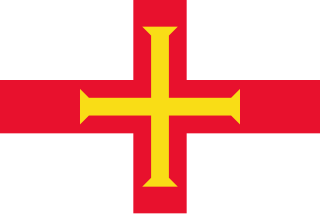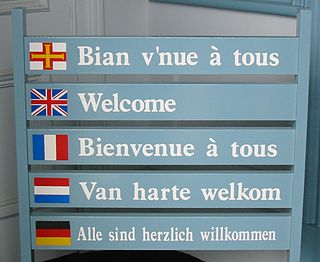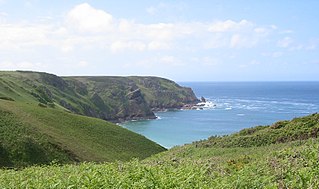| Sercquiais | |
|---|---|
| Sarkese, Sark-French | |
| sercquiais, lé sèrtchais | |
| Native to | Sark |
Native speakers | 3 (2022) [1] |
Early forms | |
| Latin | |
| Language codes | |
| ISO 639-3 | – |
| Glottolog | None |
| IETF | nrf-CQ [4] |
Sercquiais (French pronunciation: [sɛʁkjɛ] ), also known as lé Sèrtchais, Sarkese or Sark-French, is the Norman dialect of the Channel Island of Sark (Bailiwick of Guernsey).
Sercquiais is a descendant of the 16th century Jèrriais used by the original colonists; [5] 40 families mostly from Saint Ouen, Jersey who settled the then uninhabited island, although influenced in the interim by Guernésiais (the dialect of Guernsey). It is also closely related to the now-extinct Auregnais (Alderney) dialect, as well as to Continental Norman. It is still spoken by older inhabitants of the island and most of the local placenames are in Sercquiais.
In former times, there may have been two subdialects of Sercquiais, but today the dialect is relatively homogeneous. [5] The phonology of the language retains features lost in Jèrriais since the 16th century.
Relatively little Sercquiais has been transcribed, and as there is no widely accepted form, it has received a certain amount of stigma as a result. A notable ruler of Sark, Sibyl Hathaway, who was a speaker herself, proclaimed that it could "never be written down", and this perception has continued in the years since.
The earliest published text in Sercquiais so far identified is the Parable of the Sower (Parabol du smeaux) from the Gospel of Matthew. Prince Louis Lucien Bonaparte, linguist, visited the Channel Islands in September 1862 in order to transcribe samples of the insular language varieties, which he subsequently published in 1863:
Which in the NIV is translated as:
As of 2022, Sercquiais had three native speakers. [6] The Czech linguist Martin Neudörfl has been trying to preserve the language by teaching it to children. [6] [7] He has also conducted many tests, and created hundreds of hours of recordings, so that audio of pronunciation and rhythm — how the language sounds — is preserved. [6] Since 2019, the language has been taught in schools. [6]
| Labial | Alveolar | Post- alveolar | Palatal | Velar/ uvular | ||
|---|---|---|---|---|---|---|
| Nasal | m | n | ɲ | |||
| Plosive | voiceless | p | t | kʲ | k | |
| voiced | b | d | ɡʲ | ɡ | ||
| Fricative | voiceless | f | s | ʃ | ||
| voiced | v | z | ʒ | ʁ | ||
| Rhotic | r | |||||
| Lateral | l | ʎ | ||||
| Approximant | plain | j | ||||
| labial | ɥ | w | ||||
|
| ||||||||||||||||||||||||||||||||||||||||
Sercquiais does not have the voiced dental fricative which is such a distinctive characteristic of St. Ouen in Jersey where most of the colonists came from.
| Sercquiais | Jèrriais | English | French |
|---|---|---|---|
| lyer | liéthe | to read | lire |
| kuoradj | couothage | courage | courage |
| fere | féther | to iron | repasser (ferrer: to clad in iron) |
Palatalisation of velars /k/ and /ɡ/ (see Joret line) is less fully developed in Sercquiais than in Jèrriais. Palatalisation in Jèrriais of /k/ to [tʃ] and /ɡ/ to [dʒ] has the equivalent in Sercquiais of /kj/ and /ɡj/. For example, hiccup is hitchet in Jèrriais and hekyet in Sercquiais; war is respectively dgèrre and gyer.
Palatalisation of /tj/ in Jèrriais leads to [tʃ], but in Sercquiais /t/ is generally retained: profession, trade in Sercquiais is meeti, whereas Jèrriais has palatalised to mêtchi.
[dʒ] is retained in Sercquiais where Jèrriais has reduced to [ʒ], as in to eat: mãdji (Sercquiais) – mangi (Jèrriais).
Final consonants of masculine nouns in the singular are in free variation with null in all positions except in liaison. Final consonants are usually pronounced at ends of phrases. Final consonants are always lost in plural forms of masculine nouns. A cat may therefore be kat or ka in Sercquiais, but cats are kaa. For comparison, Jèrriais cat is usually pronounced /ka/, and the plural has the long vowel as in Sercquiais. It can also therefore be seen that length is phonemic and may denote plurality.
Sercquiais has also retained final consonants that have been entirely lost in Jèrriais, such as final /t/ in pret (meadow – pré in Jèrriais as in French).
Metathesis of /r/ is uncommon in Sercquiais, and in Jèrriais, by comparison with Guernésiais.
| Sercquiais | Jèrriais | Guernésiais | English |
|---|---|---|---|
| krwee | crouaix | kérouaïe | cross |
| mekrëdi | Mêcrédi | méquerdi | Wednesday |
The palatalised l, which in Jèrriais has been generally palatalised to /j/ in initial position and following a consonant, is maintained in Sercquiais.
| Sercquiais | Jèrriais (li representing /j/) | English |
|---|---|---|
| blyakyĩ | bliatchîn | shoe polish (blacking) |
| klyüt | cliu | patch |
| plyechi | pliaichi | to place |
| lyef | lief | roof |
Gemination occurs regularly in verb conjugations and gerunds, as in Jèrriais but in distinction to Guernésiais.
| Sercquiais | Jèrriais | Guernésiais | English |
|---|---|---|---|
| machunnii | machonn'nie | machounn'rie | masonry |
| dje dmãdde | jé d'mand'dai | je d'mànd'rai | I'll ask |
However, Sercquiais does not geminate palatal fricatives, unlike Jèrriais:
| Sercquiais | Jèrriais | English |
|---|---|---|
| brachii | brach'chie | brewery |
| brachii | brachie | armful |
| mãdji | mangi | to eat |
| mãdji | mang'gie | eating |
In the second half of the 19th century the language changed considerably. We can observe this in the 40 idiolects that can be heard today. An important part of the language is the usage of diphthongs, which affects the pronunciation. It is unclear how words are pronounced because there are many possible ways to pronounce them depending on where they are in the phrase. It is important to codify the language since not even the native speakers follow all the rules. [9]
The St. Ouennais origins of Sercquiais can be seen in the 2nd and 3rd person plural forms of the preterite. Sercquiais uses an ending -dr which is typical of the St. Ouennais dialect of Jèrriais, but generally not used elsewhere in Jersey (nor nowadays by younger speakers in St. Ouen).
| Sercquiais | Jèrriais (St. Ouennais) | standard Jèrriais | English |
|---|---|---|---|
| i vuliidr | i' voulîdrent | i' voulîtent | they wanted |
| uu paaliidr | ou pâlîdres | ou pâlîtes | you spoke |
| i füüdr | i' fûdrent | i' fûtent | they were |
| uu prẽẽdr | ou prîndres | ou prîntes | you took |
Type: language Subtag: nrf Description: Jèrriais Description: Guernésiais Description: Sercquiais Added: 2015-02-12 / Type: region Subtag: CQ Description: Sark Added: 2023-02-07

The Channel Islands are an archipelago in the English Channel, off the French coast of Normandy. They are divided into two Crown Dependencies: the Bailiwick of Jersey, which is the largest of the islands; and the Bailiwick of Guernsey, consisting of Guernsey, Alderney, Sark, Herm and some smaller islands. Historically, they are the remnants of the Duchy of Normandy. Although they are not part of the United Kingdom, the UK is responsible for the defence and international relations of the islands as it is for the other Crown Dependency, the Isle of Man, and the British Overseas Territories. The Crown Dependencies are neither members of the Commonwealth of Nations, nor part of the European Union. They have a total population of about 171,916, and the bailiwicks' capitals, Saint Helier and Saint Peter Port, have populations of 33,500 and 18,207 respectively.

Sark is an island, part of the Channel Islands in the southwestern English Channel, off the coast of Normandy, France. It is a self-governing British Crown Dependency, with its own set of laws based on Norman law and its own parliament. It was a royal fief until 2008. It has a population of about 500. Sark has an area of 2.10 square miles (5.44 km2). Little Sark is a peninsula joined by a natural but high and very narrow isthmus to the rest of Sark Island.
Jèrriais is a Romance language and the traditional language of the Jersey people. It is a form of the Norman language spoken in Jersey, an island in the Channel Islands archipelago off the coast of France. Its closest relatives are the other Norman languages, such as Guernésiais, spoken in neighbouring Guernsey, and the other langues d'oïl.

The Bailiwick of Guernsey is a self-governing British Crown Dependency off the coast of Normandy, France, comprising several of the Channel Islands. It has a total land area of 78 square kilometres (30 sq mi) and an estimated total population of 67,334.

Norman or Norman French is a langue d'oïl. The name "Norman French" is sometimes also used to describe the administrative languages of Anglo-Norman and Law French used in England. For the most part, the written forms of Norman and modern French are mutually intelligible. The thirteenth-century philosopher Roger Bacon was the first to distinguish it along with other dialects such as Picard and Bourguignon. Today, although it does not enjoy any official status, some reports of the French Ministry of Culture have recognized it as one of the regional languages of France.

Guernésiais, also known as Guerneseyese, Dgèrnésiais, Guernsey French, and Guernsey Norman French, is the variety of the Norman language spoken in Guernsey. It is sometimes known on the island simply as "patois". As one of the langues d'oïl, it has its roots in Latin, but has had strong influence from both Old Norse and English at different points in its history.

Jèrriais literature is literature in Jèrriais, the Norman dialect of Jersey in the Channel Islands.

The Channel Islands are located in the English Channel, by Normandy, France. The two bailiwicks, Guernsey and Jersey, are not a part of the United Kingdom, but since the 20th century are majority English-speaking and part of the British cultural sphere. They also share a historic cultural identity with the people of Normandy.

The culture of Guernsey in the Bailiwick of Guernsey is a culture which has been shaped by its indigenous Norman language and traditions as well as French and British cultural influences. Cultural trends from immigrant communities such as the Portuguese have also been added.
Auregnais, Aoeur'gnaeux, or Aurignais was the Norman dialect of the Channel Island of Alderney. It was closely related to the Guernésiais (Guernsey), Jèrriais (Jersey), and Sercquiais (Sark) dialects of the neighbouring islands, as well as continental Norman on the European mainland.

St Ouen is one of the twelve parishes of Jersey in the Channel Islands. It is around 8.8 kilometres (5.5 mi) north-west of St Helier. It has a population of 4,097. The parish is the largest parish by surface area, covering 8,525 vergées (15 km2), and is located in part on a peninsula.

The Jersey Evening Post (JEP) is a local newspaper published six days a week in the Bailiwick of Jersey. It was printed in broadsheet format for 87 years, though it is now of compact (tabloid) size. Its strapline is: "At the heart of island life".

The Bailiwick of Jersey, a crown dependency in the Channel Islands, off the French coast of Normandy, has three official languages: English, French and Jèrriais. Traditionally, Jèrriais, a variety of the ancient Norman language, has been the dominant language of the Bailiwick, but the past century has seen a great decline in its usage, as well as in the use of French.

The linguistic situation of the Bailiwick of Guernsey is quite similar to that of Jersey, the other Bailiwick in the Channel Islands. English is the official language, French is used for administration, there are several varieties of Norman language used by a minority of the population, and Portuguese is spoken by some immigrants in the workforce.
Channel Island English refers to Alderney English, Guernsey English, and Jersey English and similar dialects of English found in the other Channel Islands.

The Joret line is an isogloss that divides the langues d'oïl. Dialects north and west of it preserve Latin and before ; dialects south and east of it palatalize them. In Old French the result of this palatalisation was and, which yield and in Modern French. The line was first identified by Charles Joret and published in 1883.

George Métivier was a Guernsey poet dubbed the "Guernsey Burns", and sometimes considered the island's national poet. He wrote in Guernésiais, which is the indigenous language of the island. Among his poetical works are Rimes Guernesiaises published in 1831. Métivier blended together local place-names, bird and animal names, traditional sayings and orally transmitted fragments of medieval poetry to create themes.

Augustus Asplet Le Gros or Augustus Aspley Le Gros was a Norman language poet from Jersey and a Jurat of the Royal Court of Jersey.
John Peter Collas was a British philologist. In his obituary, he was described as being "the principal Anglo-Norman scholar of the day" and "one of the leading philologists of his generation."